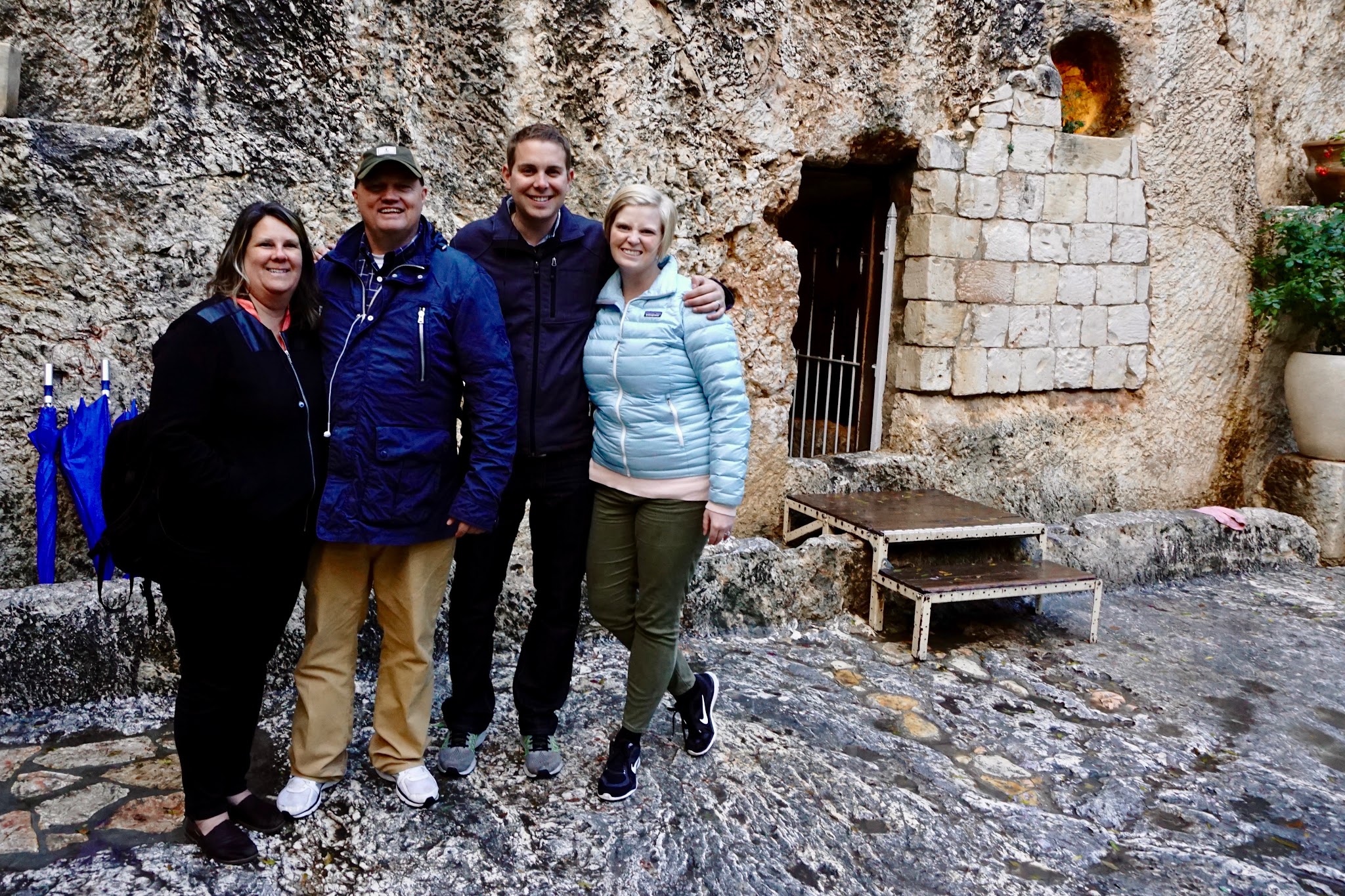
Today was a really special day in Jerusalem. We spent today walking the last few days of Jesus' life. We started on the Mt. of Olives overlook discussing the context leading up to the last week of Jesus' life. Jewish Law said that Jews had to be ritually clean one week before Passover, which is why Jesus had to go to Jerusalem. He stayed in Bethany with Mary, Martha, and Lazarus, and just before the week leading up to Passover, he raised Lazarus from the dead. This set the stage for the High Priests to determine they needed to kill Jesus. He was threatening their authority and he had to go.
 |
| View of Jerusalem from the Mount of Olives |
 |
| View of Jerusalem from the Mount of Olives |
 |
An Israeli flag under a Star of David on the Mount of Olives
|
Passover the year Christ died was on Friday. The Book of John provides the best explanation for the timing of the last week of Jesus' life. 6 days before Passover (Saturday), Mary anoints Jesus. 5 days before Passover (Sunday) Jesus does his triumphant entry into the city, which further angers the High Priest. We set the timeline on the Mt. of Olives and got some great pictures. Unfortunately, it was raining nearly all day today, so the Mt. of Olives was really windy and rainy. Fortunately, photographs of Jerusalem look great in the rain!
Our next stop was the Upper Room where the Last Supper occurred. The Book of Mark says that Jesus told his disciples to find a man carrying water. This would be very unusual in Jesus' time because women always fetched water (Rebekkah, Rachel, Jesus meeting the woman at the well, etc.). The only men typically that would carry their own water would be the Essenes because they didn't have a lot of women in their community. Essenes also had their own calendar and would have celebrated Passover on Wednesday. Jesus likely celebrated the Passover Seder/Last Supper on Wednesday with the Essenes.
 |
Alleyway where we sat as a group to go through a Passover meal
|
 |
| Steven taught us about the Passover meal |
We spent some time discussing Passover Seders. There is a very specific order that the Passover Seder happens. One of the first items on the Seder is partaking of the bitter herbs dipped in salt water. Steven asked why salt water and we responded that it represented the tears of the Israelites leaving Egypt. Although this is the tradition, this is actually never fully acknowledged WHY they had to do it that way. We talked about how sometimes God gives us commandments but doesn't explain why. The sacrament is one of the few exceptions to this.
Additionally, during some parts of the seder, the youngest person at the Seder would ask the father who is presiding questions about what makes this night different than all other nights. The rest of the adults then respond to the child. This is a representation of the hearts of the children turning to their fathers and the hearts of the fathers turning to their children.
We then moved into the Upper Room and discussed how this particular Seder was different than other Seders. First, Jesus explained WHY they were breaking the bread and blessing it. During Seder, Jews break the matzo, bless it, and pass it around. However, Jesus told them that it was in remembrance of his body. Additionally, during traditional Jewish Seder Jews will take sips of wine three different times and the fourth time they will drink the whole cup. Jesus blessed the third cup of wine and told the disciples that it represented his blood, and then told him that he wouldn't drink with them again until He was with his Father. This meant that he didn't partake of the fourth cup of wine. We then sang "Love One Another."
 |
Stained glass in an upper room site
|
 |
An upper room site
|
Our next stop was Gethsemane. We got out briefly and then got back on the bus to read scriptures because it was pouring rain. We talked about how Gethsemane meant The Wine Press of Oil. When Jews anciently made wine they stomped on the grapes to get the sweet juice without the seeds, stems, and skins which were very bitter. Once they got all the fruit juice, they would put the seeds, stems, and skins in the oil press and the juice that came out was really bitter and it was used to make vinegar.
We also talked about the sacrifice of the Red Heifer that took place on the Mt. of Olives. This sacrifice was necessary for the Priests to purify themselves before worshipping in the temple. Gethsemane could be the site of the sacrifice of the Red Heifer based on where the Holy of Holies was on the Temple Mount. Just as the Red Heifer purified the Levites from associating with death, Christ's sacrifice on the Mt. of Olives saves us from physical death.
After Gethsemane, we went to St. Peter in Gallicantu. This was one of my favorite churches from when I was here last and I visited it a few times. It's still one of my favorite sites. This is the site of the Caiphas' Palace where Jesus was tried. The basement of the Priestly Palaces would have had places to carry out punishments for breaking Jewish Law. The archaeological ruins show that this site had ropes and whips where Jews could be punished for breaking laws, such as bearing false witness. We talked about how the goal of the High Priests was to Kill Jesus. Jesus' objective was to fulfill his Father's will, which he knew would result in death. He knew that he had to be found guilty. However, he couldn't actually commit a crime, and he couldn't falsely confess to committing a crime because either of those actions would make him imperfect. Jesus instead doesn't say anything until the Priests ask if he is the Messiah. This is a question that he can answer honestly and his answer would be enough to convict him. Additionally, Jews will not say or spell the name of God anywhere. As a follower of Jewish law, this would have applied to Jesus as well. However, during the trial, Caiphas says the name of God twice (Matthew 26:63). Jesus responds to this question by saying that He will sit on the right hand of Power, rather than saying the Right hand of God.
 |
St. Peter in Gallicantu
|
 |
St. Peter in Gallicantu
|
 |
St. Peter in Gallicantu
|
 |
Doorway at St. Peter in Gallicantu
|
 |
Inside of St. Peter in Gallicantu
|
According to Catholic Tradition, Jesus was imprisoned in a pit on this site. This comes from Psalms 88, which talks about being in a pit because God has forsaken them. D&C 121 where Joseph Smith is in Liberty Jail has a lot of the same language. It was interesting to hear how similar these passages of scripture were and how Jesus comforts Joseph Smith by saying that the Son of Man hath descended below everything, including being imprisoned in a pit.
 |
Tradition has it Jesus was lowered into this pit
|
 |
Holding areas under St. Peter in Gallicantu
|
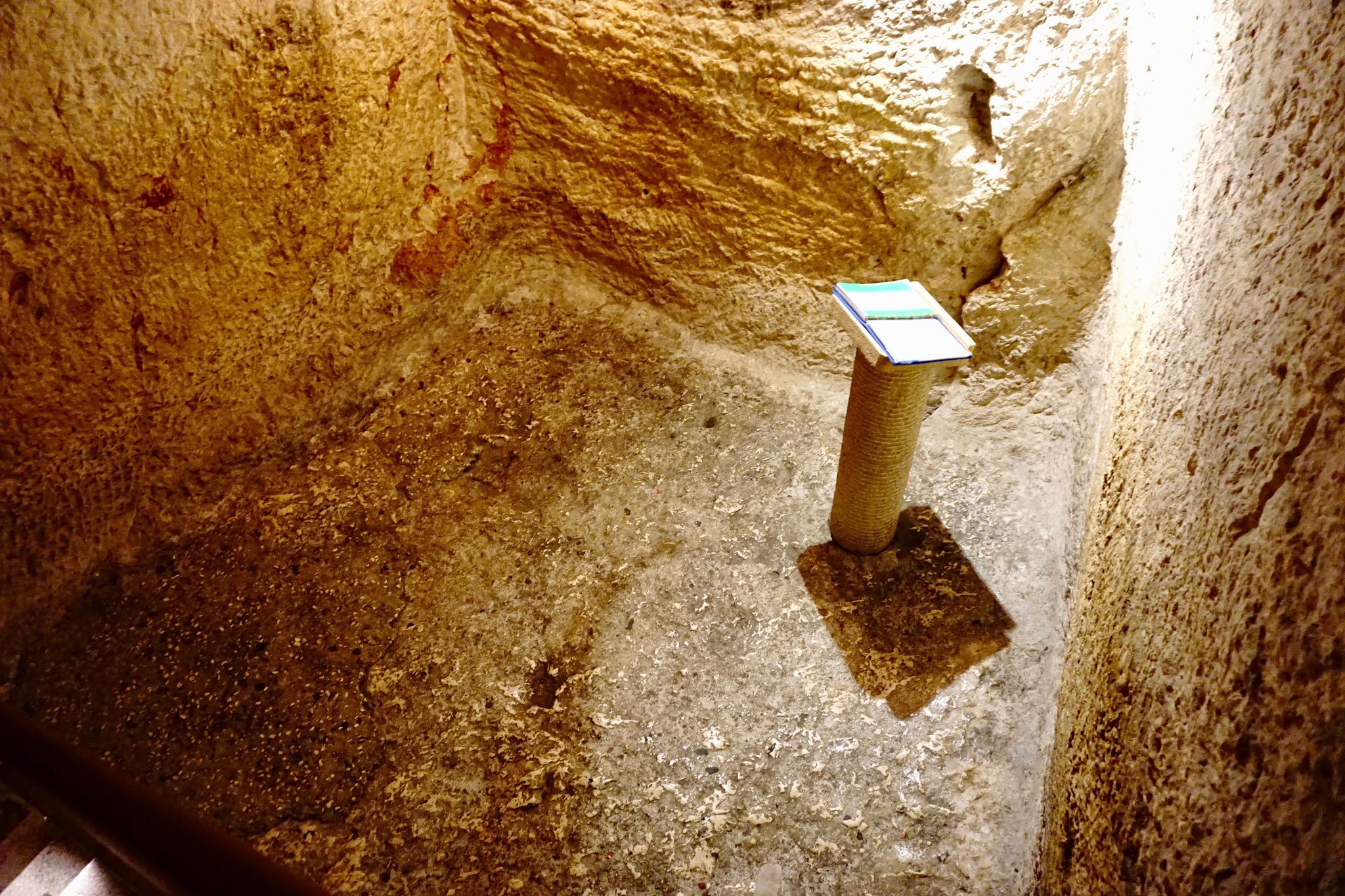 |
The pit where tradition is Christ was held after the first trial at Caiphas' palace
|
 |
This is the opening that would have been used to lower prisoners into the pit
|

Additionally, St. Peter in Gallicantu is the site where Peter denies knowing Christ three times. Steven had a very interesting perspective on this situation. The Jews at the time of Christ were looking for a political Messiah similar to Moses or David. Peter was a blue-collar fisherman called to be a disciple that was likely also looking for a political Messiah. He knows that Jesus is the Christ, however, he doesn't really understand exactly what that means. When he becomes militant in the Garden of Gethsemane, he is likely waiting for Jesus to become a political Messiah and save all of them. When Peter denies Christ, this may be the first time that he realizes that Jesus is going to die and therefore he is NOT the political Messiah that Peter thought he would be. When he denies Christ, he's truly saying that he doesn't really know who Jesus is. When he sees Jesus after he has been beaten and has already suffered the atonement and would have bloody clothes, it's no wonder he wept bitterly. He just realized that his best friend is going to die and there's nothing that he can do about it. Furthermore, he is soon going to be the leader of Christ's followers. This is obviously a daunting task for a man who was simply a fisherman 3 years prior. Peter was steadfast in his resolve to stay with Christ until the end. Additionally, after Christ's resurrection, he then asks Peter 3 times if Peter loves him. Peter replies affirmatively all 3 of these times after finally understanding what the Messiah's divine role was.
 |
| View of the Old City. This road is part of the traditional Via Delarosa |
 |
The army of Israel. There was a significant increase in the number of soldiers and police throughout the old city in anticipation of Trump's announcement that the US will recognize Jerusalem as the capital of Israel.
|
 |
A large menorah and Jewish flag in the Old City
|
 |
| The Damascus gate. The archway visible behind the tree and to the left would have been where the gate was near the time of Christ. At this same level examples of Herodian stone is visible. |
Our final stop of the Day was the Garden Tomb. We had a guide from the Tomb and she was delightful. Our first stop was Golgotha where we discussed how this would have likely been a place for many crucifixions, and as such the Romans likely would have always had vertical beams in place to carry out their punishment. The evidence for this site is that it is outside of the City Walls. The Church of the Holy Sepulcher is inside of the City Walls currently and although the walls have moved, there is no archaeological evidence that it was outside of the City Walls. The second piece of evidence is that this is on a very busy road, which Romans preferred when carrying out their death penalties. Finally, the rock on the cliff looks like a skull. We discussed how Jesus was crucified right before Passover and everything had to be finished before Passover started, including getting him off the cross and buried. Fortunately, he died fairly quickly and so they didn't have to break his legs like they did the other two that were crucified with him. This fulfilled the prophecy from Exodus saying that the Passover Lamb should not have any broken bones. Additionally, according to a footnote in John 19:31, it's likely that Christ's death occurred on a Thursday rather than Friday which is tradition. This makes sense with the timeline that said that Christ would have celebrated Passover with the Essenes on Wednesday. Additionally, because he died on Tuesday he would have laid in the tomb for 3 nights, which fulfills prophesy. Furthermore, the Americas stayed dark for 3 full days, which would make sense because it wouldn't have yet been light in the Americas when Christ died, so they would have experienced darkness for three full days.
 |
| Sign for the garden tomb |
 |
| A potential site of Golgotha. The skull is becoming increasingly hard to see in the rock in this area the black and white picture was taken over 100 years ago and the skull is clearly visible in the photo. |
After Christ died he was placed in the tomb of Joseph of Arimathea. The scriptures talk about how Jesus was buried in a garden. Joseph likely owned a vineyard and there was an ancient wine press dating back to the time of Jesus in the garden. Additionally, this tomb was likely for a rich person because it was very large and would have held multiple bodies. However, Christ was the first to lay in the tomb. After he rose from the dead he took care to tidy his prayer shawl that would have covered his face. The final thing our tomb guide told us was that we don't worship a dead figure, we worship a living human being. It was really nice. It made me reflect on how grateful I am to be here with my husband and my parents and knowing that because of Christ's death and resurrection, we can all be together forever.



















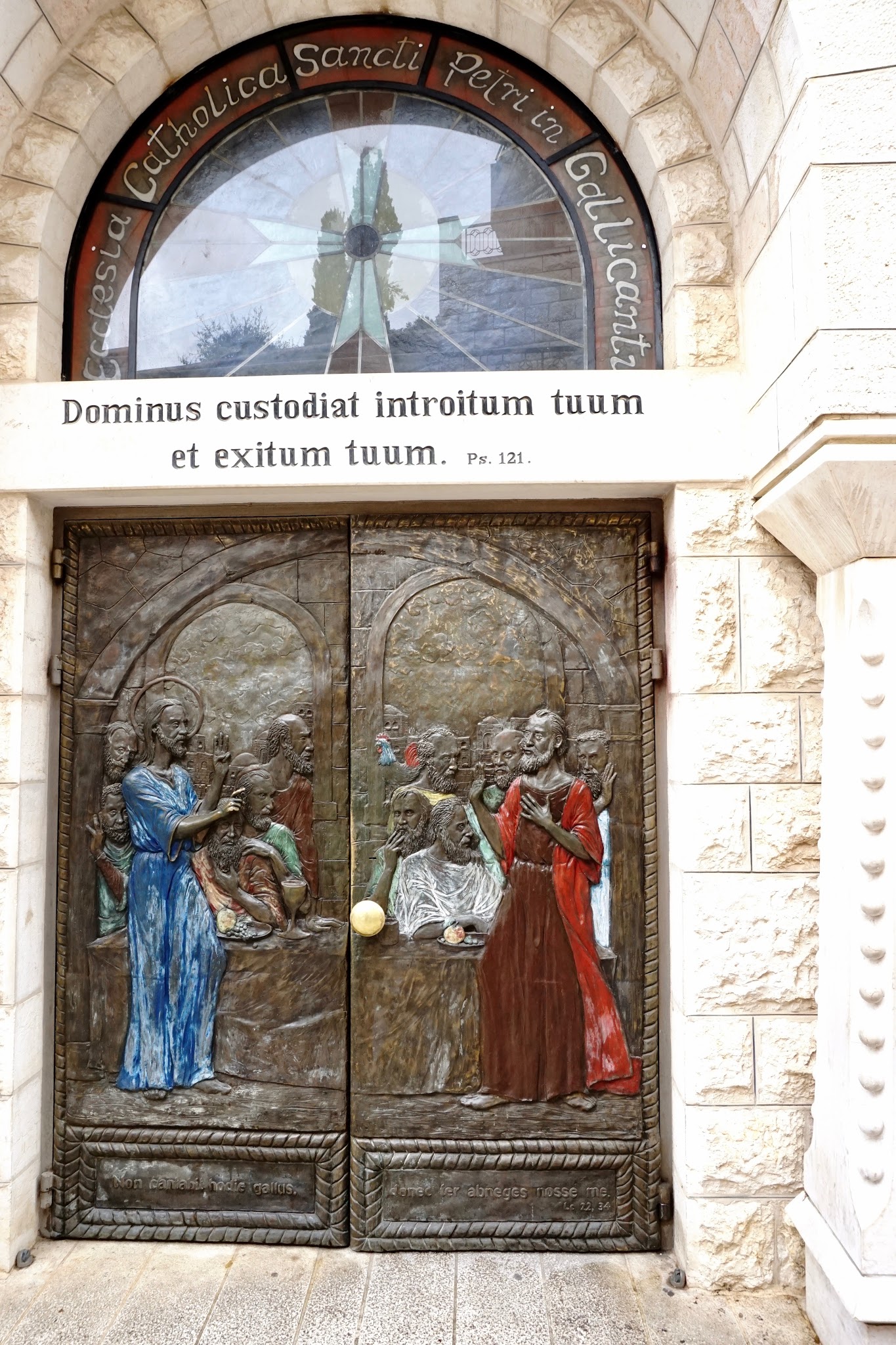





























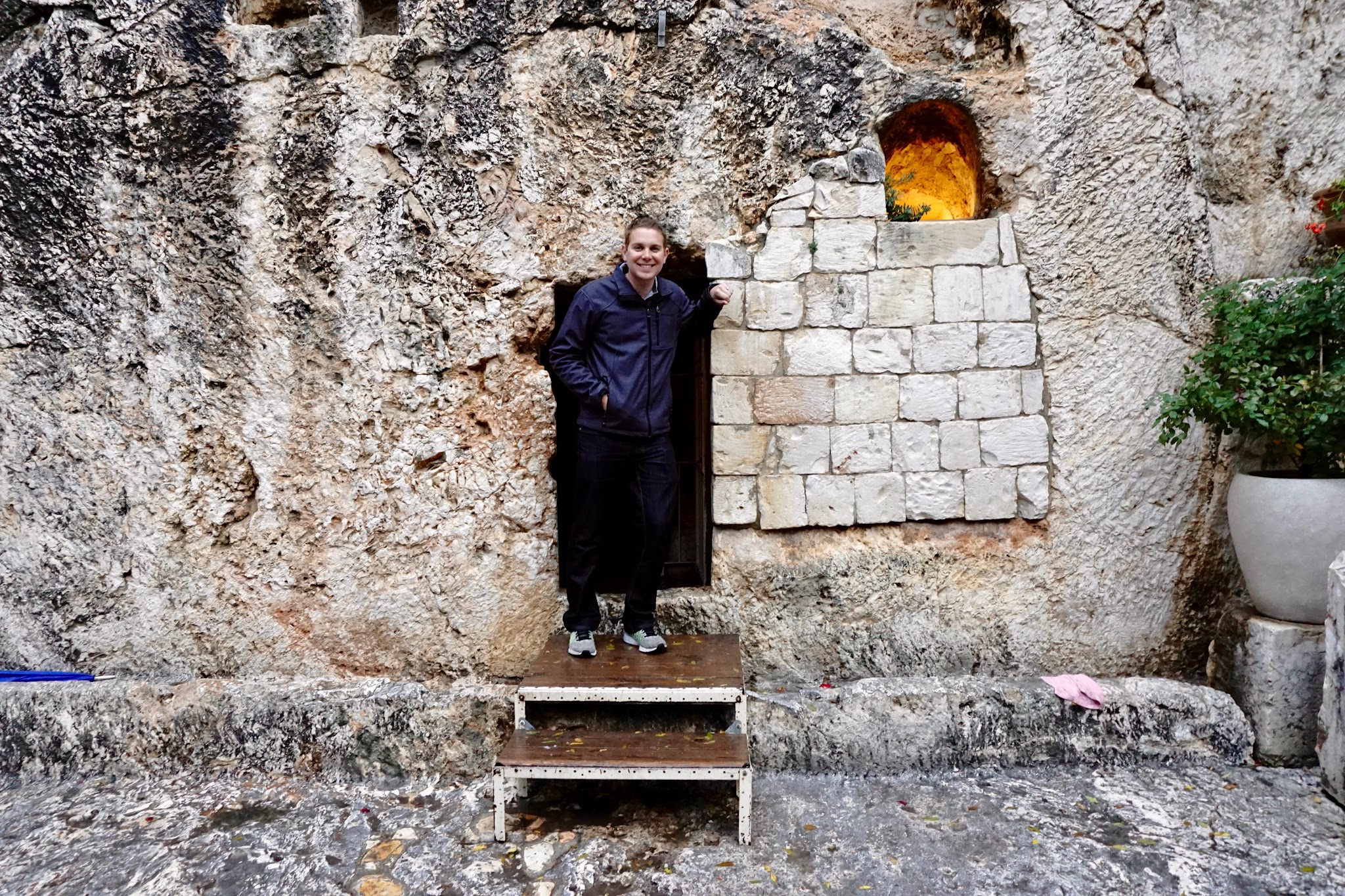
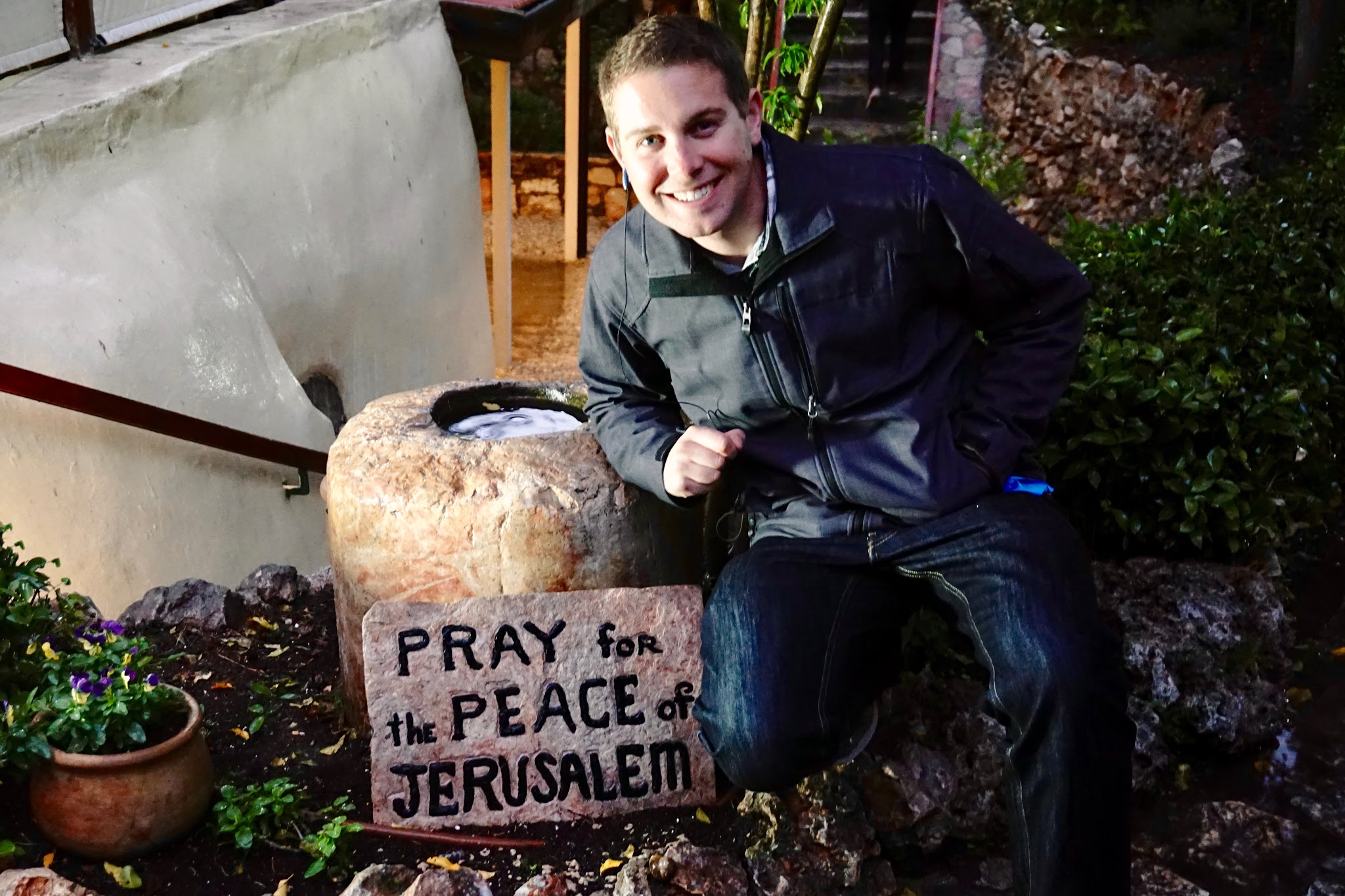



Comments
Post a Comment